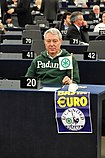Lombard regional election, 1995
|
|
|||||||||||||||||||||||||||||||||||||||||||||
|---|---|---|---|---|---|---|---|---|---|---|---|---|---|---|---|---|---|---|---|---|---|---|---|---|---|---|---|---|---|---|---|---|---|---|---|---|---|---|---|---|---|---|---|---|---|
|
|||||||||||||||||||||||||||||||||||||||||||||
|
All 90 seats to the Regional Council of Lombardy |
|||||||||||||||||||||||||||||||||||||||||||||
| Turnout | 84.24% ( |
||||||||||||||||||||||||||||||||||||||||||||
|
|||||||||||||||||||||||||||||||||||||||||||||
|
|||||||||||||||||||||||||||||||||||||||||||||
The Lombard regional election of 1995 took place on 23 April 1995. The 6th term of the Regional Council was chosen.
For the first time the President of the Region was directly elected by the people, although the election was not yet binding and the President-elect could have been replaced during the term.
Roberto Formigoni (United Christian Democrats, then Forza Italia) was elected President of the Region, defeating Diego Masi (Segni Pact) and Francesco Speroni (Lega Nord).
Lombardy used for the first time the national Tatarella Law to elect its Council. Sixty-four councillors are elected in provincial constituencies by proportional representation using the largest remainder method with a Droop quota and open lists; remained seats and votes are grouped at regional level where a Hare quota is used, and then distributed to provincial party lists.
Sixteen councillors are elected at-large using a general ticket: parties are grouped in alliances, and the alliance which receives a plurality of votes elects all its candidates, its leader becoming the President of Lombardy. If an alliance wins more than 60% of votes, only 8 candidates from the regional list will be chosen and the number of those elected in provincial constituencies will be 72; if the winning alliance receives less than 50% of votes, special seats are added to the Council to ensure a large majority for the President's coalition.
...
Wikipedia



